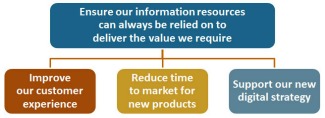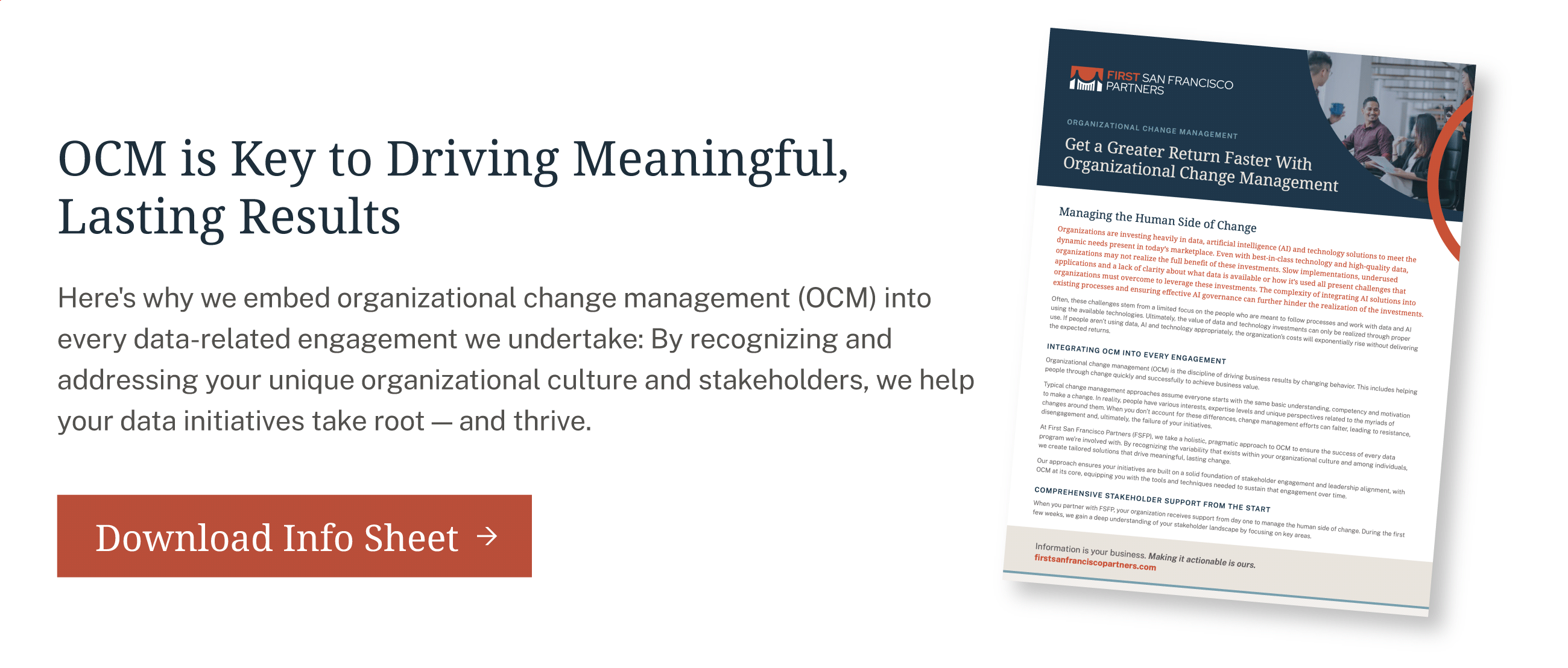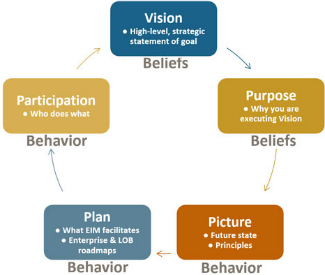I attended Enterprise Data World in San Diego a couple weeks back (read my wrap-up post) and was excited to present on a topic I feel quite passionate about: How to rally an organization around the importance of being data-driven. Based on the positive feedback I received, I thought it would be useful to share some of the key takeaways from that session.
Creating a data-driven culture is the ultimate goal of most Chief Data Officers — and, I’m sure, much of the C-Suite, too. Although there are many aspects required to accomplish this goal, the messaging and communication about what it means to be a data-driven culture is a critical place to start.
It’s a big task, but — good news — there’s a simple, yet effective five-step process for crafting content and messaging in support of becoming more data-driven. It requires answering these questions:
- How do you communicate a data-driven goal to people who don’t have data-centric roles?
- At what level in the organization is this messaging relevant?
- Who is the audience?
- How does messaging drive behavior change?
- How do you gain agreement with a diverse group of stakeholders?
It starts with company culture
What’s the culture in your organization? Is it “That’s the way we do things around here,” or “All ideas are welcomed — and expected!”? Perhaps somewhere in between?
You might define the company’s culture one way, but what about your peers, your direct reports or even your vendors? How would they describe it?
Culture is about the way people behave in your company. But beyond defining culture, you also have to prepare a plan for how to facilitate, foster, spread and reinforce it.
When I think about businesses with rich, clear and established cultures, companies like REI, Zappos, Southwest Airlines and Hubspot come to mind.
What drives their culture? It’s not just what the CEO said it is at the last town hall or how the new employee manual describes the culture. It goes deeper than that.
Drive beliefs and behavior to get results
Because we’re talking about culture, in the context that includes core beliefs and resulting (or linked) behavior, allow me to delve into a brief physiology lesson of how decisions are made. Before you can think about driving culture, let’s first understand the core of what drives us as humans: the limbic system.
Dan Barnett, consultant, speaker and author of Make or Break Culture: Get Extraordinary Results From People, explains that beliefs happen in the limbic system, which is at the base of the brain near our spinal cord. This is also where “fight or flight” activity occurs. The neocortex, located at the top part of the brain, controls our higher mental functions — like purposeful movement, perception and analysis. Barnett calls the limbic system’s influence on the neocortex “The Result Force,” since this is how we get the results we want.
The main idea is that beliefs drive behavior, which creates results. It’s the same thing with company culture: Beliefs and behavior create and drive it. With the right beliefs and behavior, it’s easier to get results that are consistent with the company goals.
Yet we often focus on results – metrics, progress toward goals and outcomes. The reality is that when we focus just on results and don’t realize that beliefs and behavior actually drive them, we wonder why we can’t change the culture — and why we don’t get the results we want.
5-step process to align a data-driven organization
Taking what we know about the limbic system and The Result Force, we can use that knowledge to build a framework for messaging that inspires a data-driven organization.
Adapted from William Bridges’ Managing Transitions: Making the Most of Change
Step 1: Vision
We’ve all heard of Vision Statements. A Vision Statement should:
- Include an image of the desired future state
- Be inspirational, rich and evocative
- Be high level and strategic
For example, you could use this framework: The Data Governance Program will _____, which will have _____ result and impact the business by _____.
Here’s a specific example:
— To ensure that The Company’s information resources can always be relied on to deliver the value required of them
– We will have a best in class client and account data capability to facilitate the achievement of the company’s strategic objectives
Step 2: Purpose
Next, let’s think about the business reasons for executing the vision. Your reasons could include:
- Improve customer experience
- Reduce time to market for new products
- Support new digital strategy
- Improve quarter-end closing process
There are other purposeful reasons, like improved decision-making and increasing productivity, that the vision should align with – as well as industry-specific drivers, like complying with banking regulations.
When you bring Vision and Purpose together, it’s powerful. Here’s an example:

Step 3: Picture
When you want buy-in on an idea or plan, it can be effective to paint a picture of the before and after. What is the world like now? How will it be better in the future? When a message bridges the old and new, it becomes a story that is memorable and aspirationally actionable!
Here are examples of life before being a data-driven organization — and after that change:
- Before: I view data as a burden. After: I pursue data as a key competitive asset.
- Before: Data is just a database of customer, vendor and product info. After: Data is a critical, corporate asset.
- Before: I use specific data to support my team’s goals. After: I look at data holistically to best see how it supports or inhibits our strategic direction.
Guiding Principles also help to define the way people will behave in the future. Guiding Principles are statements that articulate shared organizational values, underlie strategic vision and mission, and serve as the bases for integrated decision making. Principles address the behavioral aspect of the future state picture, and define the expected data-driven actions and guardrails. For example:
We are accountable for the data we produce: As individuals we are creating new data every day. We must make sure that it is of the highest quality by following agreed upon standards and guidelines. This will allow everyone to trust in the data that they use.
Step 4: Plan
To support the Vision, Picture and Purpose, you need to create a plan for achieving the desired future state. This includes the steps and timeline in which people will receive information, as well as the training and support needed to transition to the future culture.
Don’t forget to orient managers to tell employees how and when their worlds are going to change, and be sure to start with where people are today – and work forward.
At minimum, your plan should address these key areas:
- What these changes mean
- What EIM is facilitating
- What the enterprise roadmap looks like
- What group-specific roadmaps look like
The latter two points above are closely tied to participation, the collaborative effort necessary to drive change and realize the future state.
Step 5: Participation
This part of the framework is essential for establishing each person’s or team’s part in the future state and the plan to get there. Participation should involve showing associates their roles and relationships to each other in the future, as well as showing them the part they play in achieving the future (and the transition process to get there).
Other key areas to address:
- What is my role?
- Who does what?
- Across the Enterprise?
- Within EIM?
Laying out this foundation of participation will help them let go of the past and focus on the future.
Begin With Beliefs and Behavior
To get the results we want — a data-driven organizational culture — we need to focus on Beliefs (Vision and Purpose) and Behavior (Picture, Plan and Participation). If we want “data-driven” behavior to be a cultural norm, we can’t just address this as an end result. We need to examine and drive those aspects of decision making that aren’t part of our conscious, analytical, neocortex-based decision-making. We also need to address the limbic aspect of our decision making, our belief system. So that the behavior drives the results you want.




